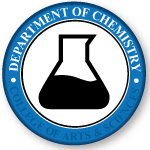Document Type
Article
Publication Date
9-2016
Publication Title
Journal of Labelled Compounds and Radiopharmaceuticals
Abstract
Regioselective labelling of arene rings via electrophilic exchange is often dictated by the electronic environment caused by substituents present on the aromatic system. Previously, we observed the presence of a t‐butyl group, either covalently bond or added as an external reagent, could impart deuterium exchange to the unactivated, C1‐position of estrone. Here, we provide nuclear magnetic resonance analysis of this exchange in a solvent system composed of 50:50 trifluoroacetic acid and D2O with either 2‐t‐butylestrone or estrone in the presence of t‐butyl alcohol has shed insights into the mechanism of this t‐butyl‐catalyzed exchange. Fast exchange of the t‐butyl group concurrent with the gradual reduction of the H1 proton signal in both systems suggest a mechanism involving ipso attack of the t‐butyl position by deuterium. The reversible addition/elimination of the t‐butyl group activates the H1 proton towards exchange by a mechanism of t‐butyl incorporation, H1 activation and exchange, followed by eventual t‐butyl elimination. Density functional calculations are consistent with the observation of fast t‐butyl exchange concurrent with slower H1 exchange. The σ‐complex resulting from ipso attack of deuterium at the t‐butyl carbon was 6.6 kcal/mol lower in energy than that of the σ‐complex resulting from deuterium attack at C1. A better understanding of the t‐butylcatalyzed exchange could help in the design of labelling recipes for other phenolic metabolites.
Recommended Citation
Stack, Douglas E. and Eastman, Rachel, "NMR analysis of t‐butyl‐catalyzed deuterium exchange at unactivated arene localities" (2016). Chemistry Faculty Publications. 22.
https://digitalcommons.unomaha.edu/chemfacpub/22
Funded by the University of Nebraska at Omaha Open Access Fund


Comments
This is an open access article under the terms of the Creative Commons Attribution License, which permits use, distribution and reproduction in any medium, provided the original work is properly cited.
Copyright © 2016 The Authors. Journal of Labelled Compounds and Radiopharmaceuticals published by John Wiley & Sons, Ltd.